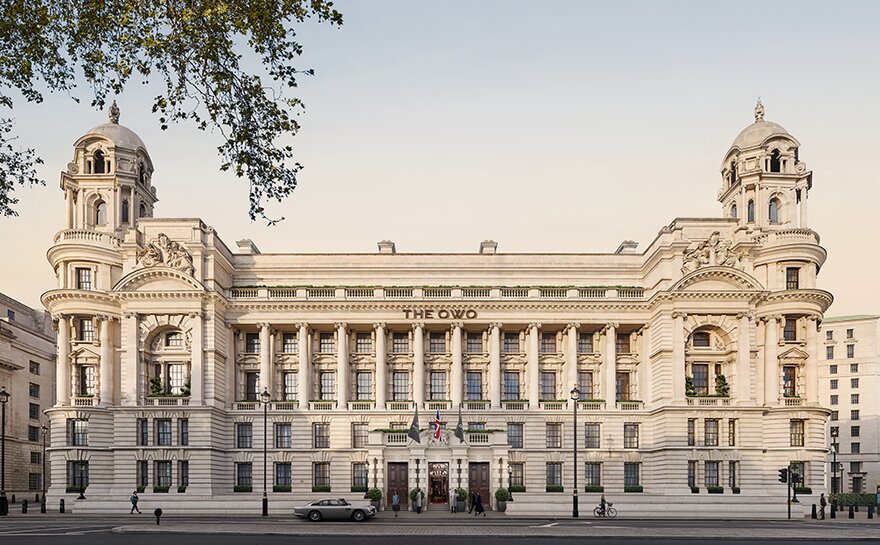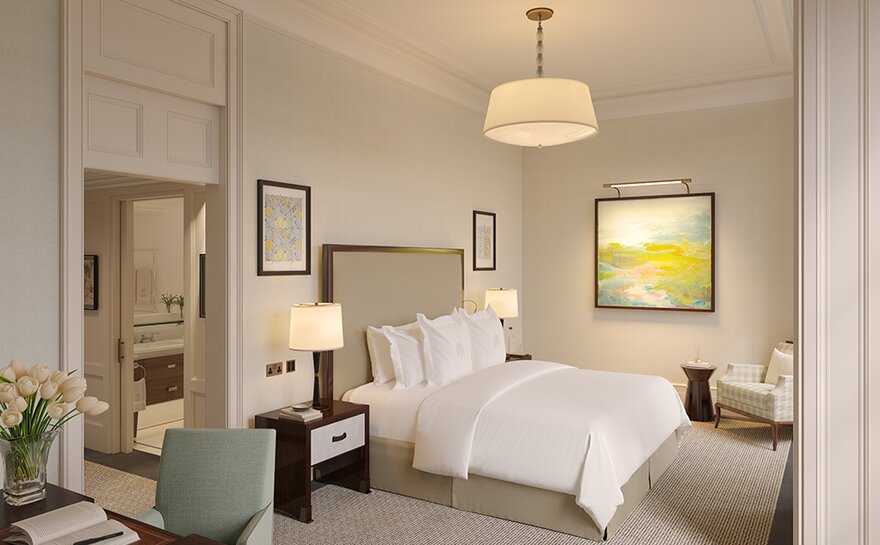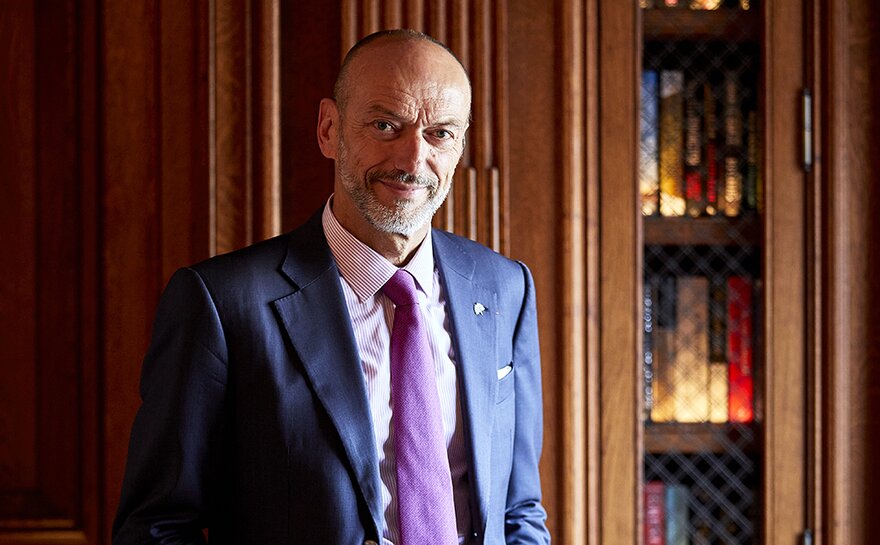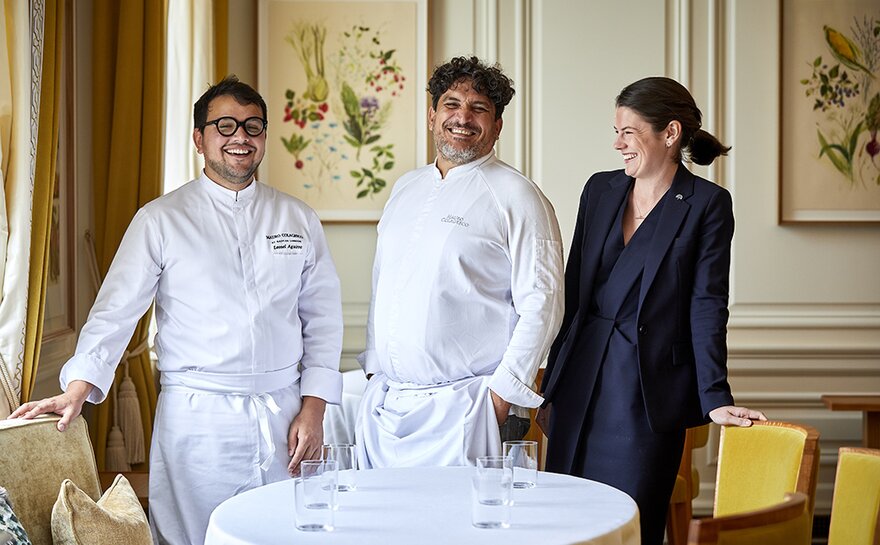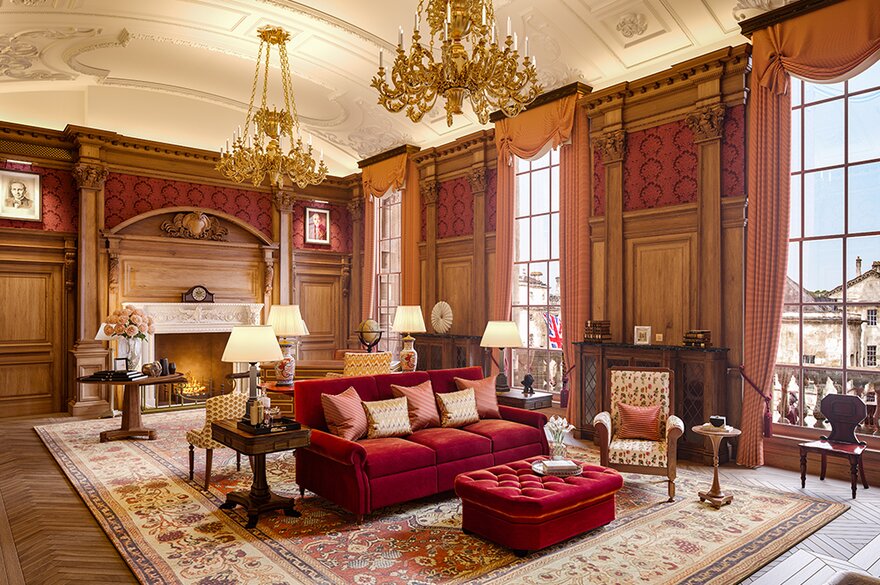Raffles London at the OWO opens this week, offering guests the opportunity to drink cocktails where spies once conspired and to rest their heads where Winston Churchill planned Allied attacks
James Bond actor Daniel Craig and Philippe Leboeuf, the managing director of Raffles London at the OWO, have two things in common. The first is they once shared the same office, admittedly in a fictional context: the exterior of the Old War Office is used to depict the MI6 offices in three James Bond movies, including Skyfall. The second – and less obvious – unifying trait is that both Leboeuf and Craig initially rejected the roles they were offered. In a 2007 interview on ITV's Friday Night with Jonathan Ross, Craig says: "I kind of walked away from [James Bond] at first because I couldn't wrap my head around it, and I didn't see myself doing it."
Sixteen years later, Leboeuf tells The Caterer: "I had been contacted twice about [the managing director role] through different channels and at first I declined because I didn't know enough about the project." Having already worked in London as general manager of Claridge's for three years between 2007 and 2010, he was not thinking of coming back to the city. But the pandemic led Leboeuf to reconsider his decision and realise it was not an opportunity to be missed.
"It took me a while, but then it's always something personal that gets into these things," he says. "I am a huge Anglophile. I love James Bond and 10% of my library in Paris, I would say, is on Churchill, World War I and World War II, so as I discovered and started to research the building, [I thought] there's nothing like it."
Fighting fit
The Old War Office, once known as Whitehall Palace, was the residence of monarchs from 1530 to 1698, including Henry VIII. It was not until 1898 that the Scottish architect William Young was commissioned to design the ‘New War Office', which would house 2,300 government and military officials. Construction started in 1901 and involved 26,000 tons of Portland stone, 3,000 tons of York stone, and 25 million bricks. At the time of completion in 1906, the Edwardian Baroque building featured 1,000 rooms and 2.5 miles of corridors spread across seven floors, totalling 818,057 sq ft.
For almost 60 years, the War Office was the central headquarters of the administration teams for the British Army and for a time the secret intelligence services. It was where the first formal meeting of the Secret Service Bureau (which later became MI5 and MI6) was held on 4 October 1909, and where the secretaries of state – Lord Haldane (1905-1912), Lord Kitchener (1914-1916) and Winston Churchill (1919-1921), to name a few – made landmark decisions. And it was where Alan Brooke, chief of the imperial general staff (CIGS) during the Second World War, made plans that would lead to the Allied victory over Adolf Hitler's Third Reich on 8 May 1945.
On 1 April 1964, the formation of the unified Ministry of Defence (MOD) led to the restructuring of the Old War Office, which was followed by an extensive refurbishment of the site in 1979. For a time, it housed the Defence Intelligence Staffs, as well as remaining MOD equipment, but the Grade II*-listed building was largely disused until it was sold in late 2014 to the Hinduja Group for over £350m on a 250-year lease.
The purchase of the property came with a condition – that the entire building remain open to the public. Thirty-seven expert consultants, including those from Historic England, were called to inspect the building. The restoration and renovation of the premises involved 5,000 staff, who spent six years polishing the stone, recarving the wood, hand-laying mosaics floors and translating history into the present.
"Londoners could not get into this building, so now it's [a chance to] give it a new history and a sense that we open up the past 100 years," says Leboeuf.
Suite success
Raffles London at the OWO is now home to 120 rooms and suites, 85 residencies (a third of which have been sold), 12 food and beverage destinations, and the below-ground, four-storey Guerlain spa, a brand that Leboeuf has collaborated with twice already during his career in luxury hotels. The opulent and majestic marble staircase, draped with a cavalry-red carpet, has been restored, while the former offices of Haldane and Churchill have been transformed into the palatial Heritage Suites, of which there are five in total. For example, the former Army Council Room, where all war-time decisions were made, is now known as the Churchill Suite, with green damask walls, intricate wooden panelling, and furniture similar to that collected by fashion designer Hubert de Givenchy.
There is one room that Leboeuf says is "sort of protected", though it has been "totally redone". The Spy Bar, playfully tucked away for guests to chance upon, pays homage to Ian Fleming, a former officer in the Royal Navy's Naval Intelligence Department, who is more widely known as the author of the James Bond series. "To be perfectly honest, I'm not quite sure how to market [Spy Bar]," confesses Leboeuf. "It will be totally open and I don't want to make it a private club, but I don't want to advertise it too much."
It's perhaps these more tongue-in-cheek touches that could attract a "little bit of a hip and young crowd", to use Leboeuf's phrase. Despite it being a five-star luxury Accor property, with room rates starting at £1,100 a night, he hopes the hotel's generous selection of nine restaurants, such as the Milanese Paper Moon and Endo Kazutoshi's sake bar, will draw Londoners to a lively F&B destination.
"Art has also been a huge pillar for us, mostly [showcasing] British inspiration and young talents, so there is a modern component. It's not just a stiff, traditional hotel," Leboeuf is keen to stress. For example, the hotel's Grand Courtyard and the restaurant that resides in it – the Parisian Café Lapérouse, an outpost of the original diner that stars in the movie Midnight in Paris – was designed by the Korean artist DaeWha Kang. The pavilion was made using stainless steel roof panels and Georgia O'Keeffe-inspired ribbed white columns, while the centre-piece fountain was finished with Aston Martin paint, acknowledging the building's link to James Bond.
Singapore translated
The hotel also inherits the Raffles tradition, which started in December 1887 with the opening of the first Raffles property in Singapore by the Sarkies Brothers. Raffles was acquired by Accor as part of a multimillion-pound transaction involving Fairmont Raffles Hotel International in December 2015. Since then, the portfolio has grown to 18 hotels and resorts, including Raffles Boston, which launched a few weeks ago as the brand's first North American property.
The group is due to welcome guests to its upcoming Saudi Arabia and Singapore resorts next year. Leboeuf says both Accor and the Hinduja Group remain "extremely involved" with Raffles London. "Metaphorically speaking, it's bringing back Raffles from Singapore to London, so in terms of responsibility and Accor, it's a huge thing."
Alice Taraschi, bar manager of the 50-cover Guards Bar and Lounge at Raffles London, is at the forefront of bringing the flavours of Raffles Singapore to the capital, alongside head bartender William Campbell-Rowntree. The original gin and cherry brandy-based Singapore Sling, which was developed by Ngiam Tong Boon at Raffles Singapore in the early 20th century, has been reimagined as the London Sling. The regional recipe is infused with local ingredients, including Sipsmith London dry gin, which is distilled in Chiswick. It also features British-grown cherries, 100kg of which were preserved for six months in a spirit, spice and sugar base in a lab on the hotel premises. The London Sling is completely clear due to a process of clarification, and is served with a cherry-filled ice-cube. "The London Sling is what we want to be championed for," Taraschi says.
For the first time in her career, Taraschi, the former deputy bar manager at Claridge's and bar supervisor at the Langham, hired "every single one" of her 19-strong team. "In my previous job, I was doing interviews, but it's different when you hire from an opening and when you hire for an existing bar. I'm super-lucky because I found such amazing people," she says, beaming.
After assembling her team in mid-August, she has been leading a "360-degree training programme", based on her readings of Unreasonable Hospitality by Will Guidara. "My main aim when training my team is to make it quite fun. I don't teach personality; we teach them basic knowledge. We want them to create a story that guests are going to talk about," she explains. She recalls a recent tasting session for the cocktail menu, which offers 16 drinks, most of which are available as non-alcoholic options. "It was exciting to see different people with different opinions. They work so well together and it feels like they've known each other for six, seven, eight months."
Leboeuf is also in the process of getting to know his 500 staff, which do not include those who work at the independent restaurants at Raffles London. Before speaking to The Caterer, he had just returned from a Wellness Walk around St James's Park with some of his team. "I don't know everybody's first name yet, but it's coming along," he says. "The approach is trying to give a bit of freedom to the staff and that has so far proven very satisfactory."
For the next six months, Leboeuf will be supported by his hotel manager, Patrick Fisher, who was hotel manager of Raffles Singapore. "Unfortunately, we could have had much more [support], but we were limited because of the visa situation and Brexit," adds Leboeuf.
Tightened visa restrictions meant that he had to look for staff from further afield, such as Australia or Canada. In fact, he estimates more than half of his team come from overseas. Housekeeping was one of the areas that proved to be a little bit more difficult to fill, followed by line staff and revenue managers. But due to Raffles' connection with Accor, which has 44 other brands, Leboeuf could fill the gaps. "I obviously have senior people from Sofitel and Fairmont, so that has allowed us to give those employees a new horizon," he says. "I have spent most of my life in the luxury, top-end hotels, but I started at three-star, four-star level, so you just have to be given the opportunity."
Leboeuf is also preparing for "quite substantial" wage increases of roughly 5% in the coming year, based on his conversations with fellow hoteliers. "My concern is not [recruitment], it's retention. I think of the butlers and the housekeepers. There's heavy Raffles training and I don't want to lose them in one year," he says.
Staffing the restaurants at Raffles
Raffles has thoroughly invested in the staffing of its three statement restaurants, which were created by the Italian-Argentinian chef Mauro Colagreco. His 120-strong brigade has been split between the all-day Mediterranean diner Saison, which is housed in the former military library, the signature fine dining restaurant Mauro Colagreco at Raffles London at the OWO, and chef's table Mauro's Table.
Colagreco, the owner of the three-Michelin-starred Mirazur in Côte d'Azur, was approached by the Hinduja family, who were former guests of the restaurant. Since joining the Raffles project in November 2021, Colagreco has been seeking partnerships with local suppliers, such as the Ethical Butcher, Flying Fish Seafood and Flourish Food, as well as producers of more obscure vegetables, such as Alwood Farm in West Sussex (for trumpet courgette) and Foskett farm in Suffolk (for sandy carrots).
"We are surprised by the quality of the product. In France, we have fantastic products, but some of them are better here," he says. Colagreco is keen to develop his own garden – "I have asked for it already" – but with the rush of the opening, the project has temporarily been put on hold. "It's one of the next steps and we are looking for something one hour from London."
Although Mauro Colagreco at Raffles London is not a vegetarian restaurant, it will be vegetable-led, showcasing over 70 varieties.
"It's all about British vegetables, the history of the vegetables and the history of England," he says. "It's a very particular approach because guests will choose the vegetables and not the animal proteins. So it's not a turbot with tomatoes, it's tomatoes with turbot."
The tasting menu is accompanied by a 40-page booklet that outlines how tomatoes were originally used by the aristocracy as an ornament; how the Victorians cultivated a new breed of strawberry; and how the eggplant entered Europe via Asia in the 14th century. In short, every inch of Raffles London at the OWO, and every slice of vegetable that is served, is woven with history.
Like the newly opened hotel, Mauro Colagreco at Raffles London is part of a wider lineage. "Mirazur is where everything started, so of course it has a big influence, but I believe a restaurant needs to be his own soul and I don't want just a copy," Colagreco explains. He has been able to build on his experience working with small suppliers in Mirazur over the past 17 years to balance the distribution of produce in London. "I have asked already, even in a structure like the hotel, to have the capacity to change the menu in the same day," he says.
Colagreco has brought a signature dish that shares a "very similar approach" to Mirazur: beetroot cooked in salt and served with caviar cream. "It's a fight between a very common product with a very luxury dish," he says. There is also mille-feuille layered with slow-cooked lamb shoulder, fresh leaves and seaweed, and an Argentinian-inspired cheese dish filled with Irish whisky – a dish his father used to make.
While the ingredients are quintessentially British, the cuisine is inflected with multiple cultures, in the same way that the Old War Office, once home to the most British of pursuits, has been reinterpreted by its Indian, Singaporean, French, Italian-Argentinian and somewhat American heirs. The late Thierry Despont, the French architect behind the renovations of Claridge's, the Beaumont and the Dorchester, designed Raffles London at the OWO but passed away on 13 August in New York. Working throughout the pandemic, he had completed his designs on Zoom and had visited the building several times, imparting his own architectural legacy in the process.
"I was very lucky to spend one full day with Thierry and Shalini Hinduja," says Leboeuf, who had asked asked for the carpet in the ballroom to be changed to something more "humble" at a late stage of the project, and Despont graciously agreed. "That's one thing I'll never forget. He took on board what I was suggesting, so I was very happy." He smiles. "I will miss him a lot."
The Heritage Suites
Thierry Despont designed five Heritage Suites in collaboration with Historic England to honour the Old War Office's most historically significant rooms. These were inhabited by prominent war-time figures such as the secretary of state for war Lord Haldane, prime minister Winston Churchill and spy Christine Granville (also known as Maria Krystyna Janina Skarbek).
Churchill's former office has been restored as the Haldane Suite, which retains its name and door plaque from the original Old War Office. It was frequented by senior military figures, such as Lord Kitchener, who is famously pictured in the 1914 army recruitment campaign poster. The suite now features wood-panelled oak, neo-baroque plaster ceilings, and sprawls across 5,382 sq ft in a series of nine interconnecting units.
Meanwhile, the Levee Rooms, which were previously used as military reception rooms to entertain important visitors and dignitaries, have been renamed as the Granville Suite. The former war room, military intelligence room and army commander-in-chief's study (where soldiers famously had their last meeting before they left for duty) have now become a sitting room, bedroom and bathroom.
The Minister of War Conference Room has also been transformed into the Raffles Suite, which is named after Stamford Raffles. It draws links to Raffles Singapore with its scenic Chinois wallpaper, Anglo-Indian style furniture and antique fireplace.
Continue reading
You need to be a premium member to view this. Subscribe from just 99p per week.
Already subscribed? Log In

